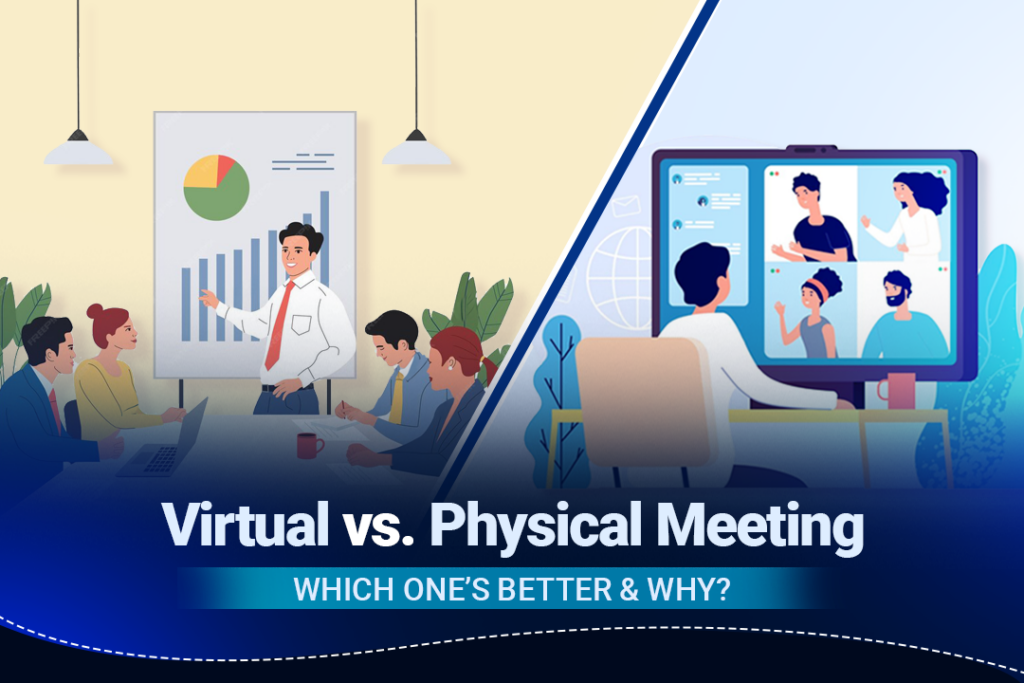
In the dynamic landscape of modern communication, the clash of virtual and physical meetings has sparked an ongoing debate over their relative merits. As technology revolutionizes how we interact, virtual alternatives increasingly challenge traditional face-to-face gatherings.
This article delves into the dichotomy between virtual and physical meetings, exploring their strengths and limitations to determine the most suitable approach for various scenarios. We aim to illuminate each method’s advantages and drawbacks, enabling individuals and organizations to make informed decisions and optimize their meeting/ conference experiences in an ever-evolving world.
What is a Virtual Meeting?
A virtual meeting is an online interaction where participants connect through technology and the internet, eliminating the need for physical presence. It enables real-time communication, collaboration, and document sharing with the help of video conferencing tools and webinars.

As remote work and digital collaboration have become prevalent, virtual meetings play a vital role in modern communication practices. It provides individuals and businesses with a flexible and efficient means of conducting interactions.
Advantages of Virtual Meetings
Virtual meetings offer numerous advantages, making them popular for communication and collaboration in various settings. Some of the key benefits of virtual meetings include:
- Global Accessibility: Participants can join from anywhere globally, overcoming geographical barriers and facilitating international collaborations without traveling.
- Cost Savings: Virtual events eliminate travel, accommodation, and other associated expenses, resulting in significant cost savings for individuals and organizations.
- Time Efficiency: Participants can quickly connect without travel time, enabling more efficient use of everyone’s schedules and fostering productivity.
- Flexibility: Virtual meetings allow participants to join at their convenience without the constraints of travel time, registration processes, or strict adherence to fixed schedules. This freedom allows for increased accessibility and adaptability to individual preferences and time zones.
- Document Sharing and Collaboration: Virtual platforms often include features for sharing documents, presentations, and screens, promoting seamless real-time collaboration.

- Recording Capability: Many virtual meeting tools offer recording options, allowing participants to review discussions later or share them with others who couldn’t attend.
- Enhanced Communication: Video conferencing facilitates face-to-face interaction, enhances nonverbal communication cues, and promotes better participant understanding. However, some rules must be followed to appear more professional and respectful. Read our article on Virtual Meeting Etiquette to learn more.
- Inclusivity: Virtual meetings can be more accessible to people with disabilities, offering options for closed captions and other accessibility features.
- Environmental Benefits: Reduced travel associated with virtual meetings lowers the carbon footprint and contributes to environmental sustainability.
- Crisis Management and Remote Work: Virtual meetings prove valuable during emergencies and facilitate remote work arrangements, ensuring continuity in critical situations.
Virtual meetings have become a practical and efficient way for individuals and organizations to connect, collaborate, and conduct business globally. One of the most significant requirements for meetings to go smoothly and professionally is that the participants master the art of effective virtual speaking. To learn more about this, you can check out our article, “A Comprehensive Guide to Master the Art of Virtual Speaking.”
Limitations of Virtual Meeting
While virtual meetings provide numerous advantages, they also have limitations that can impact the overall meeting experience. Some of the critical limitations of virtual meetings include:
- Technical Issues: Internet connectivity problems, software glitches, and hardware malfunctions can disrupt the meetings and lead to delays or difficulties in communication.
- Lack of Non-Verbal Cues: Virtual meetings may lack some non-verbal communication cues, making it challenging to gauge participants’ emotions or reactions accurately.
- Distractions and Multitasking: Participants may get easily distracted or engage in multitasking, leading to reduced focus and engagement during the meeting.
- Limited Personal Connection: The absence of physical presence can hinder the development of personal relationships and bonding among participants.
- Time Zone Differences: Coordinating meetings across different time zones can be challenging and may inconvenience some participants.

- Security Concerns: Virtual meetings can be susceptible to security breaches and unauthorized access if not adequately protected.
- Communication Barriers: Language barriers or audio issues may impede effective communication, especially in international meetings.
- Reduced Attention Span: Prolonged virtual meetings can lead to participant fatigue and decreased attention span.
- Difficulty in Brainstorming and Creativity: Collaborative brainstorming and creative sessions may be less effective in virtual environments than in-person interactions.
- Technology Learning Curve: Some participants may face challenges adapting to new virtual meeting tools and technologies.
Understanding these limitations and proactively working to mitigate them can lead to more successful and productive virtual meetings.
What is a Physical Meeting?
A physical meeting is an in-person gathering where participants come together in the exact physical location for direct face-to-face interaction. It enables immediate and intimate communication, allowing attendees to interpret non-verbal cues for better understanding and rapport.

Physical meetings have traditionally been essential for conducting business and interpersonal interactions. While they offer a personal touch and foster connection, they may require more time, resources, and coordination than virtual meetings.
Advantages of Physical Meeting
Physical meetings offer several advantages that contribute to effective communication, relationship-building, and problem-solving. Some of the key advantages of physical sessions include:
- In-Person Connection: Face-to-face interactions foster a more profound sense of connection, trust, and understanding among participants.
- Enhanced Non-Verbal Communication: Body language, facial expressions, and eye contact provide richer context and aid in more precise communication.
- Real-Time Feedback: Immediate responses and reactions allow quick adjustments, clarifications, and better decision-making. They also result in little to no miscommunication, leading to effective communication and meaningful conversations.
- Reduced Technology Dependency: Physical meetings reduce reliance on technology, minimizing the risk of technical glitches and communication breakdowns.
- Personal Networking Opportunities: Informal interactions before and after meetings facilitate networking and relationship building. Check out our complete guide to In-Person Networking.
- Focused Attention: Participants are less prone to distractions and multitasking, leading to better engagement and productivity.

- Effective Collaboration: Group brainstorming and creative sessions are often more dynamic and productive in a physical setting.
- Stronger Team Dynamics: In-person meetings help build team spirit, camaraderie, and a shared sense of purpose.
- Better Conflict Resolution: Physical proximity can aid in resolving conflicts through open dialogue and empathetic communication.
- Memorable Experience: Physical meetings’ personal and immersive nature can leave a lasting impression on participants.
While physical meetings offer unique advantages, they may only sometimes be feasible or practical, especially in remote work or global collaborations. Therefore, organizers must choose the format that is most beneficial for their setting.
Limitations of Physical Meetings
Despite their benefits, physical meetings also have limitations that can impact efficiency and effectiveness. Some of the key limitations of physical meetings include:
- Cost and Logistics: Organizing physical meetings involves expenses related to travel, accommodation, venue, and catering. These can be a financial burden, especially for global or large-scale gatherings.
- Time Constraints: Coordinating schedules and travel arrangements for participants can lead to delays and difficulties in finding a mutually suitable time.
- Geographical Barriers: Physical meetings may exclude participants who cannot travel due to distance, visa restrictions, or other logistical challenges.
- Environmental Impact: Frequent travel for in-person meetings contributes to carbon emissions and environmental pollution.
- Limited Flexibility: Once scheduled, physical meetings may be challenging to reschedule or adapt to unforeseen circumstances.
- Reduced Global Reach: Physical meetings may not be feasible for international collaborations involving participants worldwide.
- Space Constraints: Finding suitable venues for large gatherings can be challenging, especially in urban areas with limited meeting spaces.

- Health and Safety Concerns: In-person meetings can threaten participants’ health and safety during pandemics or health crises.
- Travel Fatigue: Participants traveling long distances may experience fatigue and reduced productivity during the meeting.
- Lack of Recordings: Unlike virtual meetings, physical meetings do not typically have built-in recording features, making it harder for participants to review discussions afterward.
Despite these limitations, physical meetings remain essential for specific interactions and relationship-building activities. Organizers should consider the meeting’s purpose and requirements to make informed decisions about whether a physical or virtual format would be more suitable for achieving the desired outcomes.
Key Difference – Virtual vs. Physical Meeting
Category | Virtual Meeting | Physical Meeting |
Location | Participants connect remotely via the internet | Participants gather in the same physical space |
Communication | Communication facilitated through technology | Face-to-face interaction |
Non-Verbal Cues | Limited non-verbal cues (e.g., body language) | Rich non-verbal cues (e.g., body language) |
Global Accessibility | Easily accessible from anywhere globally | May exclude participants due to travel barriers |
Cost | Cost-effective (saves on travel expenses) | Higher expenses (travel, venue, catering, etc.) |
Time Efficiency | Efficient scheduling, no travel time | Coordination and travel may cause delays |
Flexibility | Participants can join from preferred locations | Limited to a specific venue and time |
Networking | Limited informal networking opportunities | Offers ample networking before/after meetings |
Environmental Impact | Reduced carbon footprint due to less travel | Contributes to carbon emissions |
Virtual vs. Physical Meeting: What’s the Difference?
1. Location
Participants join virtual meetings from their preferred locations using internet-enabled devices like computers or mobile devices. Individuals from diverse geographic areas can participate without the need for physical travel.
Participants must gather in the exact location for physical meetings, typically at a specific venue or meeting place. This may require travel and accommodation arrangements, limiting the reach of the meeting to those who can be present at the designated location.
2. Communication
Communication is facilitated in virtual meetings through various technological tools, such as video conferencing software, webinars, and messaging platforms. Participants interact via audio and video connections, exchanging information and ideas and collaborating on shared documents.

In physical meetings, communication occurs through direct face-to-face interaction. Participants can see and hear each other in real-time, allowing for a more immediate and personal touch. This enables the use of non-verbal cues, body language, and eye contact, contributing to more precise understanding and richer interactions among attendees.
3. Non-verbal cues
In virtual meetings, non-verbal cues are often limited compared to physical meetings. Participants can use facial expressions and hand gestures visible on the video feed, but some subtleties of body language get lost due to screen size and camera positioning. This can make it challenging to interpret emotions or reactions accurately.
In physical meetings, nonverbal cues are more prominent and richer. Participants can observe each other’s body language, facial expressions, posture, and eye contact in real time, providing valuable context to the communication. This enhances the overall understanding of the message and fosters a more natural and empathetic interaction.
4. Global Accessibility
Virtual meetings offer high global accessibility as participants can join anywhere with an internet connection. This eliminates the need for physical travel, allowing individuals from different locations to attend meetings without facing travel barriers or visa restrictions.
In contrast, physical meetings may face challenges in global accessibility. Participants might encounter travel restrictions, visa requirements, or other logistical issues, making it difficult for individuals from distant locations to attend. This can limit the representation of diverse perspectives and may hinder collaborations involving international participants.
5. Cost
In today’s digital world, virtual meetings are generally more cost-effective than physical meetings. Since participants do not need to travel, there are significant savings on transportation, accommodation, and related expenses. Additionally, virtual meeting tools and platforms are often more affordable than renting physical venues, resulting in overall cost savings for individuals and organizations.
Physical meetings involve higher expenses. Participants must bear travel and accommodation expenses, such as airfare or gas. The need to rent a suitable venue, arrange catering services, and cover other logistical costs can add to the overall expenses of organizing a physical meeting.
6. Time Efficiency
Virtual meetings offer greater time efficiency regarding scheduling and participation. Participants can join the discussion from their respective locations without the need to commute, saving time on travel. This allows for more flexible scheduling options, accommodating participants from different time zones and minimizing delays.
In contrast, physical meetings may involve coordination challenges and time delays because participants need to travel to a specific location. Scheduling may become more complex, especially when dealing with participants from diverse geographical areas.
7. Flexibility
Virtual meetings offer a high degree of flexibility. Participants can join from their preferred locations, whether at home, the office, or any other convenient place. This flexibility accommodates diverse time zones, making it easier to schedule meetings that work for all attendees.

Physical meetings have limited flexibility due to specific venues and time. Participants must gather at the designated location, which may only be convenient for some. Coordinating schedules and arranging travel can be more challenging, especially when dealing with participants from different regions or countries. The fixed nature of physical meetings can make it difficult to adjust plans or accommodate last-minute changes.
8. Networking
Virtual meetings offer limited opportunities for informal networking. While participants can still interact during the meeting and engage in chat discussions, the virtual setting may lack the spontaneity and personal touch of face-to-face interactions. Virtual meetings focus more on the meeting agenda, leaving less room for casual networking.
Physical meetings provide ample opportunities for networking before, during, and after the meeting. Participants can engage in informal conversations, exchange business cards, and build relationships in a more relaxed and social atmosphere. This informal networking can lead to valuable connections, collaborations, and opportunities beyond the formal meeting agenda.
9. Environmental Impact
Virtual meetings have a significantly reduced environmental impact compared to physical meetings. Since participants do not need to travel, transportation emissions are significantly reduced. This helps to lower the overall carbon footprint, contributing to environmental sustainability and mitigating the impact of climate change.
On the other hand, physical meetings contribute to carbon emissions due to the need for participants to travel by car, plane, or other means of transportation. These emissions from travel, along with other related activities like venue energy consumption, catering, and waste generation, can have a more substantial environmental impact than virtual meetings.
#Note—Both virtual and physical meetings have strengths and limitations, and the choice between them depends on the nature of the meeting, participants’ preferences, and logistical considerations.
Navigating the Hybrid Approach
Hybrid meetings involve combining elements of virtual and physical formats to create a flexible and effective meeting strategy.
Navigating this approach requires careful planning and consideration of various factors. Here are some key steps to guide the hybrid approach:
- Define Meeting Objectives: Clearly outline the meeting’s purpose and goals. Determine which aspects best suit virtual interaction and which may require in-person presence.
- Identify Participant Needs: Consider participants’ preferences and needs, such as location, time zones, and technology familiarity. Strive to accommodate diverse preferences to ensure engagement and inclusivity.
- Choose Meeting Format: Based on the meeting objectives and participant needs, decide which portions of the meeting will be virtual and which will be physical. This could involve having some participants attend in person while others join remotely.

- Technology Integration: Select appropriate virtual meeting tools and platforms that seamlessly integrate with remote participants. Ensure that virtual participants have access to all necessary documents, presentations, and interactive features.
- Plan for In-Person Interactions: For physical meetings, arrange suitable venues that comply with safety regulations and have adequate technology support for virtual participants. Plan opportunities for informal networking and team-building activities.
- Test and Rehearse: Conduct technology tests and rehearsals before the actual meeting to identify and address potential issues in both the virtual and physical setups.
- Communication and Guidelines: Provide clear instructions and guidelines for virtual and in-person participants, including technical support and protocols for engagement.
- Promote Interaction: Encourage active participation from all participants, regardless of their attendance mode. Facilitate engagement through breakout sessions, polls, and interactive discussions.
- Record and Share: Record the virtual portions of the meeting and make them available to all participants for later review. This allows attendees to catch up on missed content and reinforces vital takeaways.
- Gather Feedback: After the meeting, collect participant feedback to assess the hybrid approach’s effectiveness and identify areas for improvement.
Organizations can use this approach to leverage the benefits of virtual and physical meetings to create a dynamic and inclusive meeting experience. Also, read about 10 Hybrid Event Best Practices to make your event successful.
Future Outlook- Virtual vs. Physical Meetings
The future outlook for virtual vs. physical meetings will likely blend both formats. Here are some key aspects of the future outlook for each type of meeting:
Virtual Meetings:
- Increased Adoption: Virtual meetings will likely see continued growth in adoption, particularly for routine and non-critical appointments. The convenience, cost savings, and accessibility of virtual interactions will drive their prevalence in various industries and settings.
- Technological Advancements: Advances in virtual meeting technologies, such as augmented reality (AR) and virtual reality (VR), may enhance the immersive experience and make virtual interactions even more engaging and lifelike.

- Virtual Collaboration Tools: Collaborative tools that facilitate brainstorming, whiteboarding, and co-editing documents in real-time will evolve and become more integrated, making virtual teamwork more effective.
- Hybrid Model: Many organizations may adopt a hybrid model, blending virtual and physical meetings to cater to diverse preferences and optimize meeting outcomes.
- Global Collaboration: Virtual meetings will continue to facilitate international collaboration, enabling organizations to work with partners, clients, and teams from different regions with ease.
Physical Meetings:
- Relevance of In-Person Interaction: Physical meetings will remain essential for certain situations where face-to-face interaction is crucial. This includes building personal connections, negotiating complex deals, and fostering team cohesion.
- Selective Usage: Organizations may organize physical meetings more selectively to minimize costs and environmental impact. They will reserve them for high-impact events and relationship-building activities.

- Focus on Experience: Physical meetings will likely focus more on providing unique and memorable experiences to justify the in-person gathering and differentiate from virtual alternatives.
- Safety and Health Considerations: Due to health concerns, especially since the pandemic, physical meetings may require enhanced safety measures and protocols to ensure attendees’ well-being.
- Flexible Venues: Meeting venues may evolve to offer more flexible and adaptable spaces to accommodate hybrid events, integrating virtual participants seamlessly.
The future of meetings will be driven by technological advancements, changing work dynamics, environmental consciousness, and the recognition of each meeting format’s unique benefits. Organizers can check out these ten best hybrid meeting platforms to strive to balance these two approaches.
Key Takeaway
Comparing virtual and physical meetings reveals a nuanced landscape in which each format offers different benefits and constraints. In navigating this dynamic landscape, carefully considering meeting objectives, participant preferences, and technology integration is critical to orchestrating meaningful and productive interactions.
Ultimately, the future of meetings lies not in an absolute preference for one over the other but in a thoughtful synthesis of virtual and physical approaches that strike a balance that best meets each interaction’s unique needs and goals. For more of the latest information about the event’s industry, visit our site- Eventible.




Comments are closed.